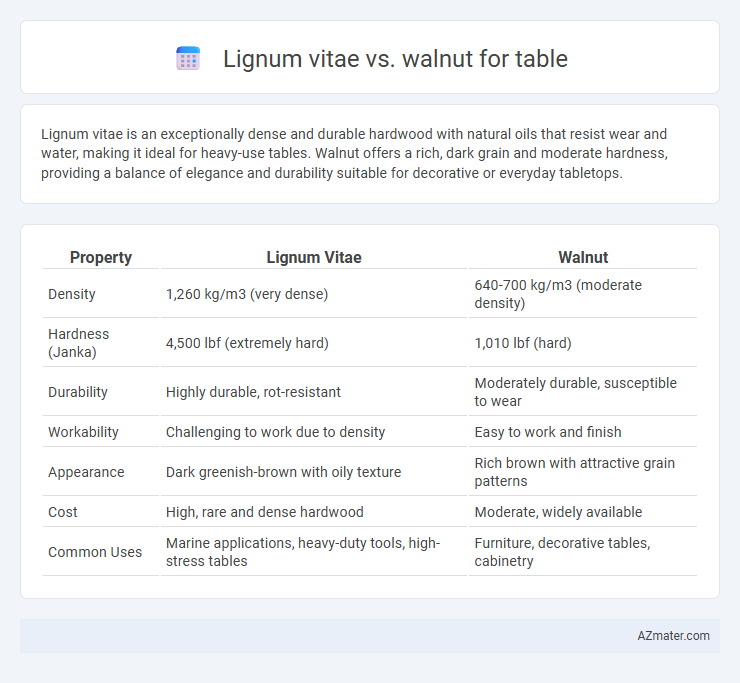Lignum vitae is an exceptionally dense and durable hardwood with natural oils that resist wear and water, making it ideal for heavy-use tables. Walnut offers a rich, dark grain and moderate hardness, providing a balance of elegance and durability suitable for decorative or everyday tabletops.
Table of Comparison
| Property | Lignum Vitae | Walnut |
|---|---|---|
| Density | 1,260 kg/m3 (very dense) | 640-700 kg/m3 (moderate density) |
| Hardness (Janka) | 4,500 lbf (extremely hard) | 1,010 lbf (hard) |
| Durability | Highly durable, rot-resistant | Moderately durable, susceptible to wear |
| Workability | Challenging to work due to density | Easy to work and finish |
| Appearance | Dark greenish-brown with oily texture | Rich brown with attractive grain patterns |
| Cost | High, rare and dense hardwood | Moderate, widely available |
| Common Uses | Marine applications, heavy-duty tools, high-stress tables | Furniture, decorative tables, cabinetry |
Introduction: Lignum Vitae vs Walnut for Tables
Lignum Vitae and Walnut are two premium hardwoods frequently chosen for tables due to their distinct qualities. Lignum Vitae is renowned for its exceptional density, natural oils that provide durability and resistance to wear, and rich greenish-brown hue. Walnut offers a deep chocolate-brown color with attractive grain patterns and a balance of hardness and workability, making it a popular choice for elegant and sturdy furniture.
Botanical Overview: Lignum Vitae and Walnut
Lignum vitae, derived from the genus Guaiacum, is a dense hardwood native to the Caribbean and the northern coast of South America, prized for its natural oils that enhance durability and resistance to decay. Walnut, primarily from the Juglans genus, is native to North America and Europe, known for its fine grain, rich chocolate-brown color, and moderate density making it ideal for high-end furniture. Both woods offer unique botanical traits that influence their strength, workability, and aesthetic appeal in table construction.
Appearance: Grain, Color, and Texture Comparison
Lignum vitae features a dense, interlocking grain with a deep olive to dark brown color, often exhibiting rich greenish or black streaks that enhance its visual depth. Walnut displays a straight to wavy grain pattern, showcasing a rich chocolate brown hue that occasionally includes purplish or gray undertones, offering warmth and elegance. The texture of Lignum vitae is oily and smooth due to its natural resin content, contrasting with walnut's fine, even texture that provides a soft and luxurious feel on table surfaces.
Durability and Hardness: Strengths of Each Wood
Lignum vitae ranks among the hardest and most durable woods, exhibiting exceptional resistance to wear, dense grain, and natural oils that enhance longevity and water resistance in tables. Walnut offers a balance of hardness and workability with a Janka hardness of around 1,010 lbs, providing good durability for everyday use while allowing intricate detailing and finishing. Choosing between Lignum vitae and walnut depends on whether extreme durability and water resistance or moderate hardness with aesthetic versatility is the priority for table construction.
Workability: Ease of Crafting and Shaping
Lignum vitae is dense and oily, making it exceptionally durable but challenging to work with using standard woodworking tools due to its hardness and natural resins. Walnut offers superior ease of crafting and shaping, featuring a fine, straight grain that responds well to cutting, sanding, and carving, making it a preferred choice for detailed woodworking. Both woods require sharp tools, but walnut's balanced hardness provides a smoother experience for artisans aiming for intricate designs.
Cost and Availability
Lignum vitae is significantly more expensive and rarer compared to walnut, due to its slow growth and limited supply. Walnut is widely available in numerous grades and price points, making it a cost-effective choice for table production. The scarcity of lignum vitae drives up its price, while walnut benefits from robust harvesting and faster replenishment rates.
Environmental Impact and Sustainability
Lignum vitae is renowned for its exceptional density and natural oils, making it highly durable and resistant to pests, which reduces the need for chemical treatments and extends the life of furniture, thereby lowering environmental impact. Walnut, while less dense, is often sourced from sustainably managed forests with certifications like FSC, promoting responsible harvesting and reforestation efforts. Choosing walnut supports sustainable forestry practices and carbon sequestration, whereas lignum vitae's slower growth rates and limited availability raise concerns regarding long-term sustainability in large-scale use.
Maintenance and Longevity
Lignum vitae offers exceptional durability and natural oils that resist moisture and pests, requiring minimal maintenance for tables. Walnut, while aesthetically rich with a smooth grain, demands regular sealing and careful protection against scratches and moisture to maintain its appearance. Longevity favors lignum vitae as its dense, oily wood withstands wear and environmental damage far better than walnut with less upkeep.
Suitability for Different Table Styles
Lignum vitae offers exceptional density and natural oiliness, making it ideal for heavy-use rustic and industrial-style tables due to its durability and rich, dark greenish-brown hue. Walnut is favored for contemporary, mid-century modern, and traditional table styles because of its smooth texture, fine grain, and warm chocolate-brown color that elegantly ages over time. Both woods perform well under finishing, but Lignum vitae's toughness suits outdoor and high-traffic tables, while Walnut's workability enhances intricate designs and refined aesthetics.
Final Recommendation: Choosing Between Lignum Vitae and Walnut
Lignum vitae offers exceptional density, hardness, and natural oils that provide superior durability and resistance to wear, making it ideal for heavy-use tables. Walnut, valued for its rich color, smooth grain, and ease of finishing, delivers a warm aesthetic and excellent workability, suitable for finely crafted furniture. For long-lasting functionality and strength, Lignum vitae is preferred; for versatile design and classic elegance, walnut remains the top choice.

Infographic: Lignum vitae vs Walnut for Table
 azmater.com
azmater.com